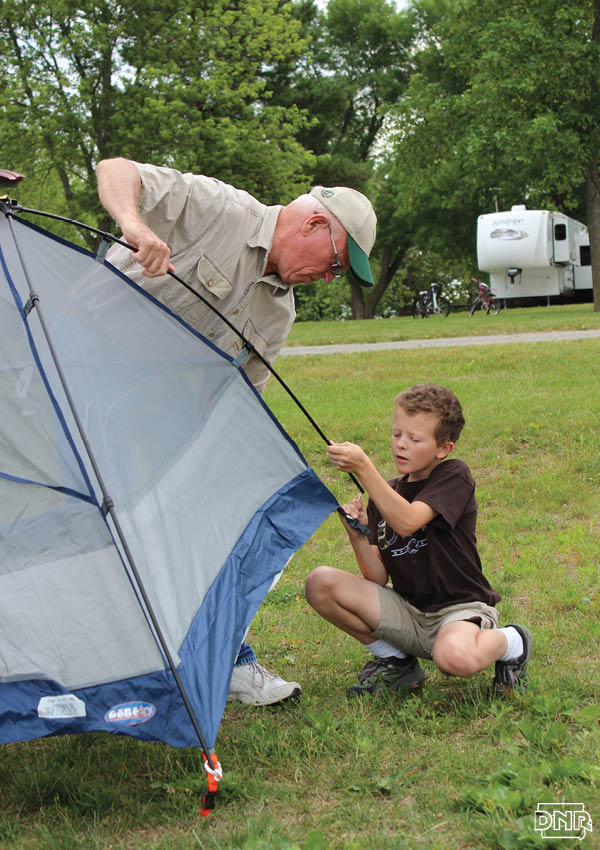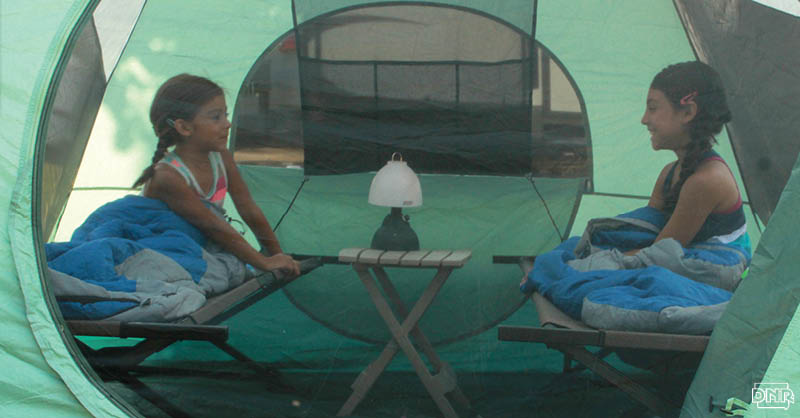The ability to successfully go tent camping in Iowa is a rite of passage for many. Roughing it without air conditioning or electronics doesn’t need to be hard, though. This list will prepare tent campers young and old, experienced or novice, with the knowledge to have a pleasant and well-prepared for adventure.
1. The type and size of tent matter.
The larger and more complex a tent, the harder to put up. If you are camping alone or as the only adult, it may be wise to get a tent that is easy to set up and tear down to save time and energy (you might want to have some activities ready to keep the kids busy while you set up). Always get a tent made of sturdy material that resists sometimes harsh winds and rain.
 2. Location, location, location.
2. Location, location, location.
Try to go for a campsite that has a steady looking tree on it to provide some shade during the day and potentially double as a place to hang a clothesline (provided it doesn’t damage the tree, of course). Without air conditioning in the heat of the summer, a breeze in the shade can do wonders to cool you down. Also, make sure that there is enough room to fit your tent onto the site. Some sites can only accommodate small tents, so check ahead of time to prevent any difficulties. Most sites have a fire pit and picnic table, but confirm ahead of time if you are unsure. Photos of state park campsites are available through the reservation system at iowastateparks.reserveamerica.com.
3. Pay attention to the wind.
You don’t want to light the campfire for some s’mores and hot dogs only to find that the smoke blows directly into the tent or onto the drying beach towels. Figure out the general wind direction before staking the tent down and finalizing the placement of food and supplies. Wind does change directions often, so prepare to move things when the need arises to prevent them from being smoked out. It is a good idea to put the tent as far from the fire pit as the site allows to help with any lingering smoke smell.
4. Sleep comfy.
Try putting down foam puzzle piece-shaped tiles (often found in the children’s toy section) for added padding under your sleeping bag. Or consider an air bed that will blow up with a hand pump or battery-powered pump. If you’d like even more sleeping comfort, there are cots specifically designed for camping that can fold down to fit into a 3-foot carrying case.
5. Stock up on firewood.
Many campers go through their firewood stockpile before the trip ends, as it often looks like you have enough until you unload it. Once it’s time for dinner and campfire treats, nobody will want to run to the closest town for more wood. Also, it is recommended that any wood you bring with you comes from the county in which you will use it. This helps to keep any pests residing in dead wood from moving to new areas. You can check ahead of time to see if your campground sells wood onsite by visiting iowadnr.gov/concessions, which lists the parks that sell firewood and the other concession services offered there.
6. Prepare meals ahead of time.
Some campers like to eat more than the traditional hot dogs and burgers during their camping trip, so make sure to have in mind everything you will need to bring to make your meal complete, including spices and condiments. When possible, pre-measure and combine ingredients ahead of time to cut down on the amount of things you have to pack for the trip. Making meals ahead of time also helps with dishes at the campsite, portioning, complex preparation that could not be possible while camping, and makes meal time faster and less messy. If you bring your trusty cast iron skillet or Dutch oven, make sure to bring oil to keep it in tip top shape and plenty of paper towels for quick clean-up. Need some new recipes? Check out our camping recipes page or our Outdoor and Wild Recipes board on Pinterest.
7. Don’t bring more food than you can safely store.
A large cooler full of ice is a necessity for any summer camping trip. Pack the cooler before leaving for the trip to ensure that there is ample room not only for the food you want to keep cool, but also for the ice to be able to reach everything and keep it cold enough. You will need to buy more ice as your trip progresses, but starting with a large block of ice at the bottom paired with loose smaller cubes and keeping the cooler in a shady spot should decrease how often you need to buy ice. You can also freeze water in gallon milk jugs and use it as ice in the cooler – it’s less messy and provides cooking and drinking water as it thaws. Try bringing a collapsible shelf to store non-perishable food on such as cereal and chips, and a refrigerator thermometer to ensure food stays at a safe temperature.
